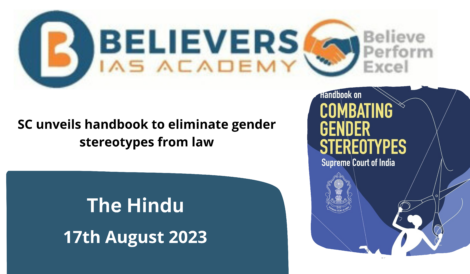SC Collegium’s quiet transparency is driving change
Context :
Through a selection process that includes “meaningful discussion on and assessment of candidates’ judicial acumen,” the Supreme Court Collegium, led by Chief Justice of India D.Y. Chandrachud, has subtly and transparently streamlined the appointment process of judges to the constitutional courts.
What is Collegium and how do they work in choosing the Judges?
- Appointment of Judges: Judges of the Supreme Court are appointed by the President following consultation with the Chief Justice of India and other senior judges of the Supreme Court and High Courts, according to Article 124 of the Indian Constitution.
- Evolution of the collegium System: The Bar Council of India’s recommendations from 1981 are what gave rise to the idea of the collegium system, in which a group of judges recommend nominations to the President.
- Second Judges’ Case (1993): In this case, the Chief Justice of India and the senior-most judges were consulted before the President was appointed, overturning the earlier process of appointment. With the opinions of senior judges taken into consideration, the Chief Justice’s judgement was regarded as collective.
- Third Judges’ Case (1998): A nine-judge panel improved the collegium structure in this case. The collegium, which consists of the Chief Justice and the four senior-most Supreme Court judges, should be consulted before the Chief Justice forms an opinion, the document emphasised. Senior judges from the pertinent high courts were also asked for their opinions in writing.
- Composition of the collegium: The collegium system, which was developed in India, was originally intended to have a broad base and incorporate representation from many authorities. However, only judges of the higher courts remained in the final composition.
- the Collegium System’s rules: The Third Judges’ Case specified a number of rules for the collegium system, such as the significance of consensus in recommendations, taking judges’ seniority into account, and offering compelling justifications for a candidate.
- Collegium System Criticisms: The collegium system has been criticised for its narrow representation and lack of extensive engagement with non-judicial bodies. These concerns highlight the requirement for changes to increase accountability and openness in the appointment process.
- Justifications for the Collegium System: Despite its flaws, we might contend that the collegium system is the best way to protect judicial independence and public confidence in the judiciary within the confines of the Indian constitutional framework. It guarantees that judges’ independence and qualifications are taken into consideration while making appointments.
What are the changes done by the Chief Justice of India D.Y. Chandrachud in making the Collegium system more transparent?
- Streamlined Appointment Procedure:
-
-
- The collegium has attempted to simplify the selection procedure for judges in India’s constitutional courts.
- To achieve a skilful balance between seniority and merit in the selection of judges, it has implemented reforms.
-
- Emphasis on Transparency:
-
-
- The collegium has made transparency a priority in both its resolution-making and decision-making processes.
- The qualifications for applicants being taken into consideration for appointments to the Supreme Court and High Courts are made public.
-
- Focus on Judgement Quality:
-
-
- The collegium places a high priority on candidates’ judgement quality.
- The collegium members receive candidate evaluations well in advance for review.
- To aid in the evaluation process, the Centre for Research & Planning of the Court provides pertinent background information.
-
- Committee for Judgement Evaluation:
-
-
- To carefully assess applicants’ judicial work, the collegium established a Judgement Evaluation Committee.
- The committee assigns a grade to the decisions, with “outstanding” being given to the best ones.
- This impartial evaluation procedure attempts to guarantee a thorough assessment of candidates’ relative merit.
-
- Criteria for Supreme Court Appointments :
-
-
- The collegium takes into account three main factors when suggesting candidates for Supreme Court appointments:
- senior puisne judges and chief justices at their respective parent high courts.
- The judges’ integrity, performance, and merit are being taken into account.
-
- Diversity and Inclusion:
-
-
- The Supreme Court needs to be inclusive and diverse.
- The collegium’s discussion on diversity and inclusion in the judiciary is its main topic.
- It strives to provide Supreme Court representation for underrepresented High Courts.
- It takes into account gender diversity, ethnic representation, and the selection of judges from socially and economically disadvantaged groups.
-
- Criteria for Chief Justices of high courts:
-
-
- The Memorandum of Procedure (MoP) outlines the collegium’s objective criteria for choosing Chief Justices of High Courts, which are followed by the collegium.
- When choosing Chief Justices, the various High Courts are fairly represented.
- Based on their seniority, puisne judges are considered for inter-se seniority in their own High Courts.
-
- Gender Diversity:
-
-
- To advance gender diversity, the collegium suggested Justice Sunita Agarwal as Chief Justice of the Gujarat High Court.
- The High Courts did not have a female Chief Justice at the time the proposition was made.
-
- Objectivity in Decision-Making:
-
-
- By refusing to allow three High Court judges’ requests to object to their out-of-state transfers, the collegium displayed objectivity.
- The transfers were suggested to ensure improved justice administration.
- The government swiftly informed the transfers and agreed with the collegium’s judgement.
-
- Governmental Support:
-
- The government is no longer as critical of the collegium system’s secrecy as it once was.
- The government now receives notice of recommendations made by the collegium within days.
- A more collaborative approach resulted from the Law Ministry’s new top-level leadership.





